https://www.aarp.org/politics-society/history/info-2020/protestor-stories.html
Marching for Social Justice
How older Americans are demanding change
AARP, June 12, 2020
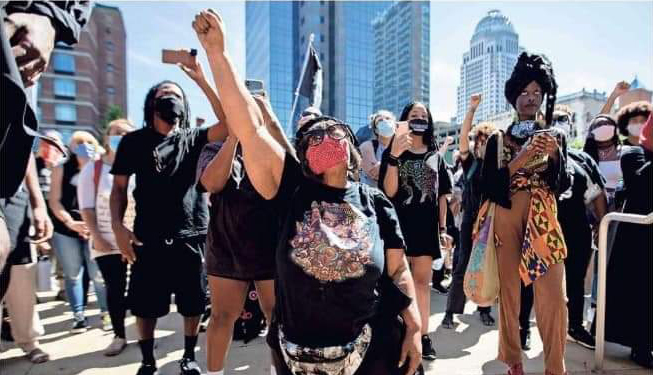
MAX GERSH/COURIER JOURNAL
Rhonda Mathies gets down on her knees and sings ‘We Shall Overcome’ at a protest in downtown Louisville.
En español | Over the past two weeks millions of Americans have protested in cities across the country to demand social justice and racial equality. And older Americans have been adding their voices and perspectives to those demonstrations.
For some, marching in the street is nothing new — they have attended rallies and protests for decades to bring awareness or demand change on important social issues. For others, the death of George Floyd in police custody has spurred them to action for the first time.
Either way, to hear them tell it, these new protests feel different. Here are some of their stories.
Rhonda Mathies, 69, Louisville, Kentucky, retired social worker
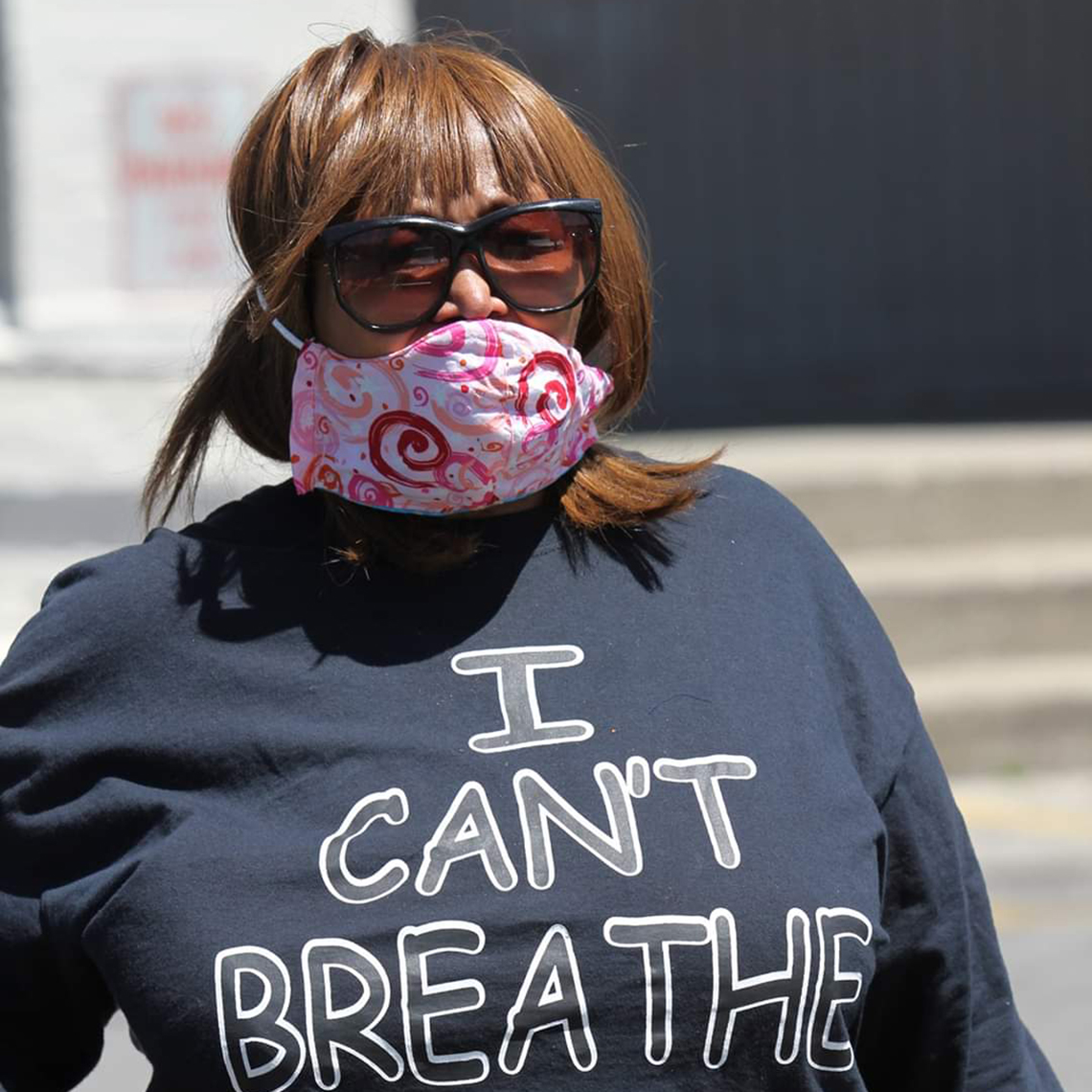
COURTESY RHONDA MATHIES
Louisville Metro Police, Kentucky State Police and the National Guard were downtown at Sixth and Jefferson streets on May 30. They were dressed in riot gear and on horses, on foot and on the rooftops. The kids were in the middle of the street chanting “Hands up,” “I can’t breathe,” and “No justice, no peace.” Some were lying down in the street. I went over to the side to pray. I went down on my knees. A black girl, maybe in her 30s, younger than my two daughters, said, “Ma’am, get up. The police are ready to move.” I said I wasn’t getting up because I was praying, and she said, “You’ll get locked up,” and I said, “I don’t care.” But she eased me up. When I opened my eyes the police were coming straight at us. A state trooper on foot took his baton and pushed her, and when he did that, I had a flashback to Alabama in the 1960s, and I broke down and started crying.
I’ve been protesting a long time. I started in the school system seeing how black kids were being treated academically and emotionally. It was always a constant struggle. I’m tired. I’m tired for my people. I keep saying it’s up to the next generation, but knowing what my ancestors have been through, my inner being propels me back out to the streets.
In some ways, these are the best of times because we have a diversity of consciousness, but it can’t be just a moment; it’s a movement. The police are not going to magically do the right thing. Racism is still alive. It’s institutionalized.
Cherry Steinwender, 78, Houston, executive director, Center for the Healing of Racism
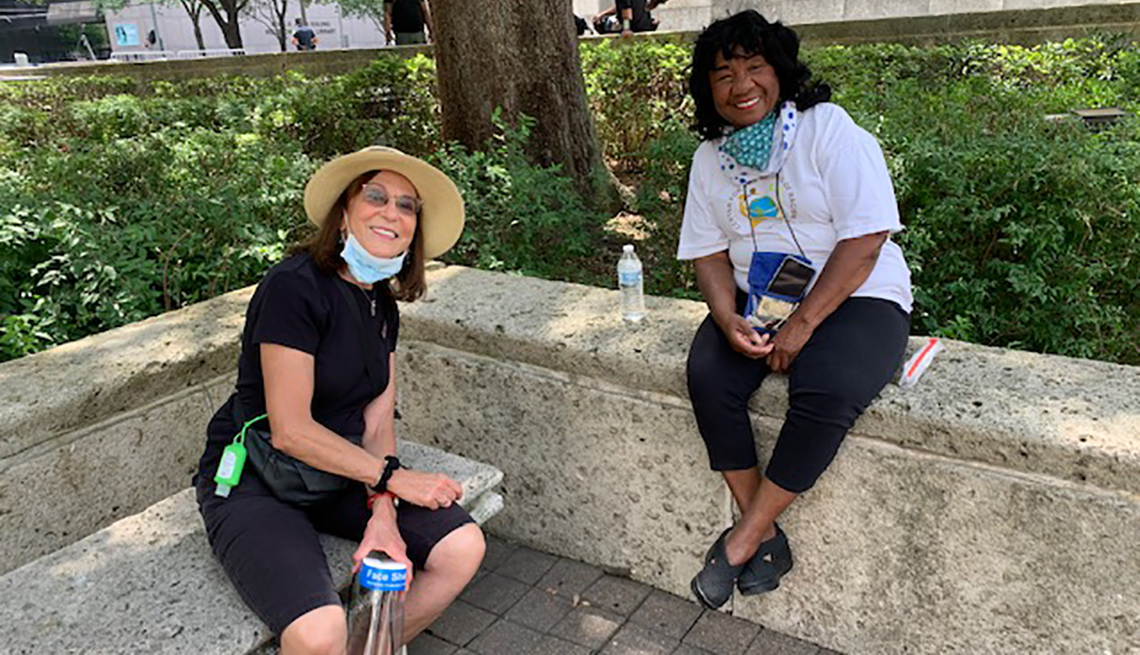
COURTESY CHERRY STEINWENDER
Cherry Steinwender, right, with her friend Ana Eigler, 67, on the day of the protest.
I was at the protest [June 2] with 60,000 people in front of City Hall in Houston [George Floyd’s hometown]. It was exhilarating to see so many people of so many ethnicities. It made me so proud; we were looking like what the whole city looks like.
The other exhilarating thing for me was to see all of the signs of protest that people carried. I had one with our organization’s logo and the words “Internalize Oneness.” That’s a powerful statement because people have [the] oneness [of humanity] in their heads, but they haven’t moved it to a place where it really makes a difference. They haven’t internalized it.
For instance, I will never say “people of different races” because I truly believe that’s part of the problem. You can’t have it both ways. You can’t say that we all are the same human family with at least 99.9 [percent] DNA in common, and then at the same time turn around and look at me as if I’m a different race than you. To me that doesn’t equate. My husband is white, blond with blue eyes. He’s Austrian. And he and I will never, ever refer to each other as an interracial couple.
We were a very diverse group of friends that started this organization, Center for the Healing of Racism, back in 1989. We were third-generation Japanese American, European American, African American, Latino. [The group’s founding] was in response to the silence about racism. You know, whenever you do mention it, it’s “Pass the sugar please.” You don’t talk about it.
So that joy I was feeling at the protest seeing all those different people — it made me feel that now something’s going to change. There’s something different about this.
Nick Sheridan, 71, Baltimore, humanist celebrant
I went to a protest that was huge, several thousand people. There were a lot of homemade signs, which is really good to me because it means people aren’t just following a trope. They’re thinking and feeling and putting up signs that say what they feel.
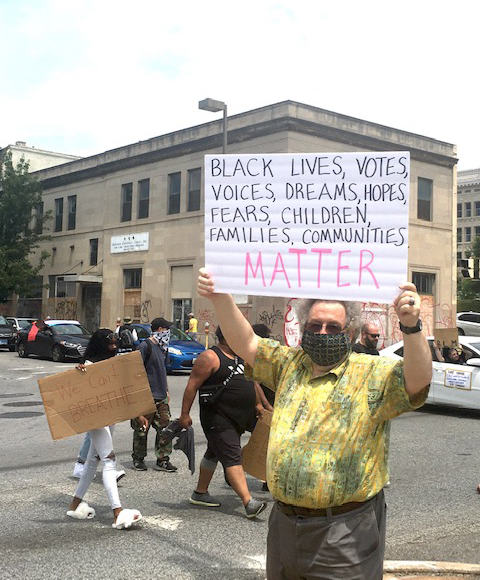
COURTESY NICK SHERIDAN
And people here keep on creating different forms of protest. I belong to an organization that has a lot of older members who are nervous about going on a march because of coronavirus, so they’re organizing a car caravan with signs that they’ll hold out of the window. People are being really creative. They’re starting to realize that we can’t progress as a country unless we start to deal with this.
I went on a ride-along with the Baltimore police six or seven years ago. They invited community leaders and I was leading a community group, and there was no violence on that ride-along, no obvious violence, but the way they dealt with black people and white people — there was just such a horrible contrast. It was disrespectful.
I wrote about it and when it was published in the Baltimore Sun, the police press officer called me and asked me the name of the officer. I said, “I’m not gonna give you the name of the officer because you punishing that one officer gives the illusion that one officer is rogue, and all that officer was doing was following the culture of the department.”
When someone is murdered we [often] hear about it, but these minor forms of disrespect and harassment and bullying, we don’t hear about. But it’s part of black people’s lives every day.
Don Samuels, 71, Minneapolis, former Minneapolis City Councilman
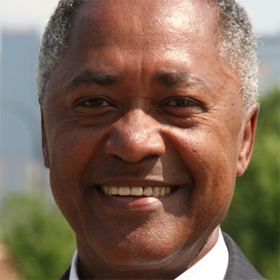
COURTESY DON SAMUELS
When we were marching on the Interstate 35W Bridge June 2, we couldn’t even see where the march began. Everyone was very cordial. But it got dramatic fast. People started running across the freeway to escape a giant tanker truck driving 30 miles an hour into this crowd of thousands. We thought maybe this truck had a bomb in it that would destroy the whole bridge and kill everyone. Then incredibly — like something out of a Mad Max movie — about eight courageous guys clambered onto this moving truck and slowed it to a stop and took the driver out. Those guys might have saved all of our lives.
I was raised in Jamaica and arrived in America as a 20-year-old. I went to college out East and I’ve lived in Minneapolis since 1990. I spent 30 years as a design executive in the toy industry and ran for Minneapolis city council. At the end of my designing career, I graduated from a seminary and still preach. My wife and I marched in two protests and observed others. I wanted to get my skin in the game and take part in transformational changes.
When I went to the [recent] Minneapolis protests, I expected to see more people my age, but they were so young.
In every company I worked for I was the first African American in that position. I came in the door minutes after it opened. I had opportunities. It still wasn’t easy. But I got [to the U.S.] after the hard work of the [1960s] marches was over. Then I became a part of the establishment. When [George Floyd’s death] happened, I thought, My God, now I’m on the other side.
Mallorie Baron, 60, Berkeley, California, middle school teacher
I teach Spanish to middle schoolers and went out Saturday [June 6] to the protests in Berkeley, where I live. The mood was quite jovial. A lot of music; a lot of young people. Very upbeat.
I’m a single parent. My daughter is 20 and in college, and as she began to educate me, it became clear to me that we have a COVID pandemic and we have a racism pandemic. We have two viruses.
I thought, I need to get up and move. All of us need to move.
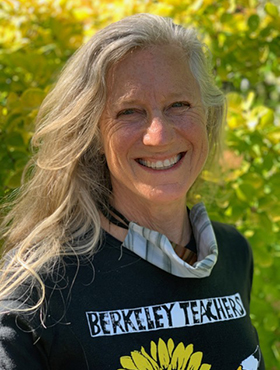
MALLORIE BARON, PHOTO BY LINDA ZAGULA
Everybody wore a mask. It had to be several thousand people on Martin Luther King Jr. Way chanting, “Say his name: George Floyd” and “Say her name: Breonna Taylor.”
I carried a sign saying “Black lives always matter.”
I saw my neighbor at the march wearing a double mask. She is a widow in her early 80s. Her husband was a professor at University of California, Berkeley.
I was with friends age 50-plus. It was a lot of young families. Maybe 15 percent there were age 60 and above.
The event was put on by the Black Student Union at Berkeley High and by Malcolm X Elementary School. There were a lot of speakers.
I went to make noise, to demand change; I couldn’t sit back and be quiet. In the past I marched in support of the #MeToo movement, against climate change, against [President] Trump. I also did a lot of protesting in my younger years.
I’m so incredibly proud of our young people who are not stopping until there is real change — institutional change — in our world towards creating a more just society, where people of any color can feel that they’re going to get justice. I feel like we’re at a turning point and it’s taken a long time to get here.
We all need to make change however that is: You’re protesting, you’re donating money, you’re donating time, you’re volunteering. You’re being compassionate with everybody.
Elizabeth “Liz” Palacio, 62, East Chicago, Indiana, retired steelworker
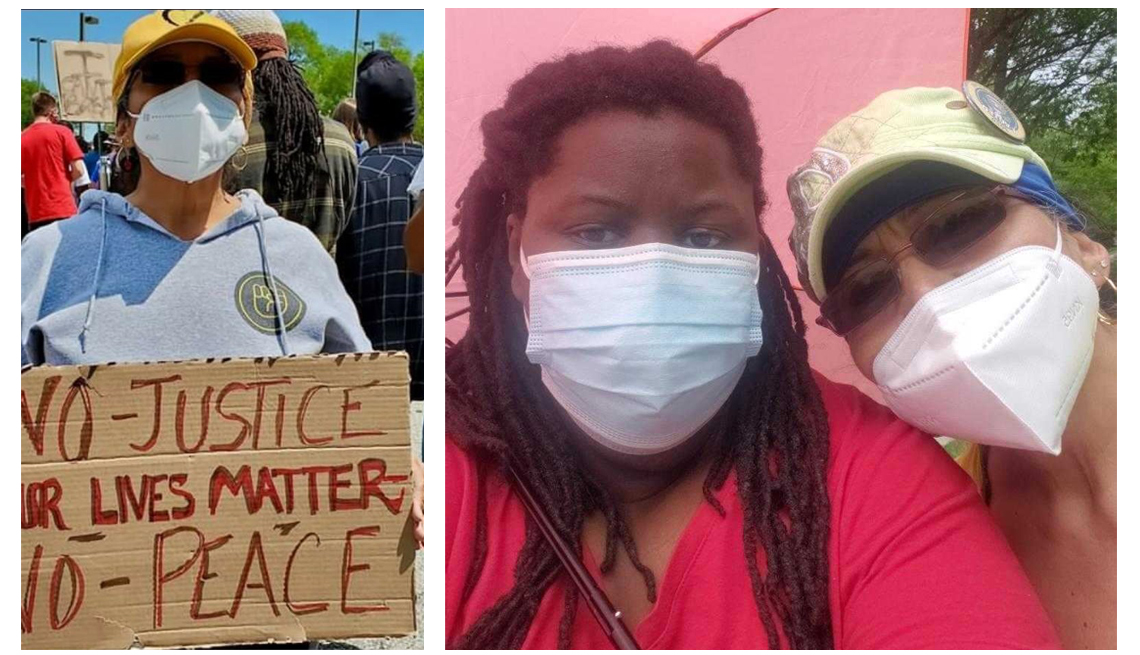
(L) COURTESY LIZ PALACIO, (R) SELFIE COURTESY LORRELL KILPATRICK WITH LIZ PALACIO (YELLOW HAT)
As a brown-skinned woman, I have felt the sting of racism and discrimination. I know a lot of people were afraid to go out [to protests], and I like to stand up for them to make sure their voices are heard. I’m a divorced mother of three who is now engaged. I worked 33 years for ArcelorMittal, which used to be called the Inland Steel.
Now that I’m retired, I want to do things I couldn’t do when I was raising my children. Nobody can sit on the sidelines anymore.
Most of the demonstrators at the Hammond, Indiana protests wore masks and tried to socially distance. They wiped down and sanitized the microphones. A lot of protestors carried signs that said “Black Lives Matter” and “Say their names.” They shouted out the names of George Floyd and Breonna Taylor. A few protesters got teargassed at one of the protests.
I’m glad I went because it gets the word out. We are making people aware and waking them up. We try to give voice to the voiceless.
I’m a God-fearing person. I wasn’t scared though. I said a prayer beforehand. That’s why I’m never afraid.
Freddye Hill, 74, New Orleans, retired social sciences professor

COURTESY FREDDYE HILL
Last Saturday I participated in the march against police brutality in New Orleans organized by the Rays of Love group, which is led by young people. It began in City Park, with more than 1,500 black, white, Asian, Latinx, Native Americans — young and old. I was deeply moved by the organizers’ attention to detail: They were giving out extra masks, water and snacks along the march route. And I was struck by the irony of speakers standing atop the pedestal that once held the statue of Confederate General P.G.T. Beauregard [that was taken down after protests in 2017]. I marched for an hour and left because of a thunderstorm.
My activism to advance the cause of civil rights, human rights and social justice, began when I was 16 and I joined the NAACP youth council. It included protest marches to desegregate the movie theatre in Tampa, even though my father objected.
I’ve seen a lot of changes in my life. In June of 1964 I left Tampa on a segregated Greyhound bus to go stay with my aunt in Atlanta. Two months later I went back to Tampa to get my clothes for college and it was on an integrated bus.
Crocker Stephenson, 64, Milwaukee, retired journalist
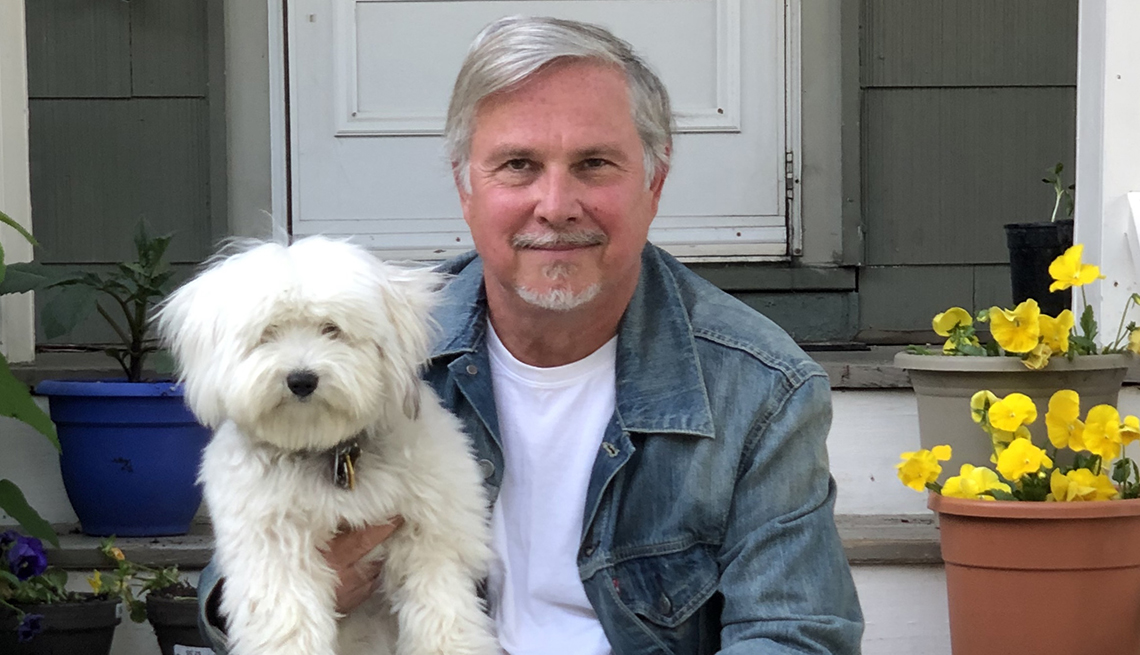
COURTESY CROCKER STEPHENSON
I was walking our dog, Camus, a fluffy white Coton de Tulear, with my daughter, Irene, around 9 p.m. in my East Side Milwaukee neighborhood [on May 31] when I heard the sounds of the protests growing louder. I didn’t have my glasses or wallet. I wasn’t even wearing socks.
I was a Milwaukee Journal Sentinel reporter for 34 years. I retired in 2019. I hadn’t been to a demonstration that I didn’t cover as a reporter since the 1970s. But this is my neighborhood and I wanted to show my support. I told my daughter, Irene, to take Camus’ leash and tell my wife I’d probably get arrested.
If things got crazy I wanted to be there to temper both sides. I didn’t want bad things to happen in my neighborhood.
People were yelling and screaming and some were quite angry. It was chaotic, all noises and dark and light. It was a confusing blur to me. That might have been one reason I went to the front of the police line.
I am visually impaired with a degenerative retinal disease. I can’t see well, so I thought that the police officers ahead of me were actually demonstrators. When I got there, I saw my mistake. The police were all dressed in black riot gear from head to toe: helmets and shields and batons. They stood shoulder to shoulder ready for combat. So I said, “Let’s keep this peaceful.” Then I turned around, stepped back up, knelt down and faced the police, with my arms in the air.



conversation starters on tinder
May 16, 2021 8:09 amconversation starters on tinder
Cherry Steinwender is interviewed by AARP – CENTER FOR THE HEALING OF RACISM
any free dating site in usa
May 19, 2021 7:06 pmfree real dating sites
totally free dating sites no upgrades
May 20, 2021 9:37 amfree online dating site 2021
completely free dating sites uk only
May 20, 2021 9:54 amtop free black dating sites
dating sites india free
May 26, 2021 6:28 pmfree adult dating no credit card
free chat dating sites uk
May 27, 2021 12:36 amtotally free smoker dating
xxx free dating
June 1, 2021 11:58 amfree jewish dating sites
free all access dating websites
June 1, 2021 12:33 pmtotally free no credit card dating sites
free philippine dating sites
June 1, 2021 4:19 pm100% totally free dating sites
free pof dating site plenty of fish
June 23, 2021 10:47 pmpopular dating websites for free
arabic dating sites free
June 24, 2021 1:43 amfree dating sities
list of free european dating sites
June 25, 2021 2:00 amtop 10 free dating site in county state in anerica
free online dating games sims
June 25, 2021 9:29 amfree dating site in canada
whereloveisfound.com free dating site
June 25, 2021 7:32 pmfree online interracial dating sites
alkaline keto diet
July 6, 2021 2:52 pmketo bakery
keto taco soup
July 6, 2021 6:32 pmwhat is dirty keto
what can you eat on keto diet
July 7, 2021 2:16 pmketo diet tips
dating as a gay programmer
August 9, 2021 3:59 pmgay mexican dating site https://gaychatrooms.org/
dominant gay dating
August 9, 2021 6:54 pmgay speed dating portland https://gaychatus.com/
gay dating in saudi arabia
August 9, 2021 9:41 pmdating korean chinese gay men https://gaydatingzz.com/
gay girls dating
August 10, 2021 2:40 pmgay dominant dating sites https://gaychatgay.com/
free gay dating sites android
September 1, 2021 7:07 pmbuzzfeed lesbian gay dating https://freegaychatnew.com/
gay christian dating sites
September 9, 2021 9:10 amarab gay dating free https://gaydatinglosangeles.com/
gay dating polish
September 9, 2021 9:36 amdating gay military https://gay-singles-dating.com/
gay dating international
September 9, 2021 11:52 amhow to do gay online dating https://gaydatingcanada.com/
gay online dating
September 11, 2021 3:20 pmgay muslim dating sites https://datinggayservices.com/
gay online dating fatigue
September 11, 2021 3:40 pmgay dating inverness https://dating-gaym.com/
what to write in college essay
September 28, 2021 7:34 pmcheapest essay writing service https://essaywritercentral.com/
what to write college essay about
September 29, 2021 3:20 pmpay for essay writing https://essayghostwriter.com/
write a conclusion for an essay
October 12, 2021 6:38 amwrite a reflection essay https://essaypoints.com/
writing about yourself essay
October 12, 2021 11:55 pmwriting essays help https://essaysnet.com/
write essays for money online
October 14, 2021 10:11 pmesl essay writing https://online2casino.com/
help writing essay
October 14, 2021 11:52 pmexploring writing paragraphs and essays https://onlinecasinos4me.com/
free money casino
October 26, 2021 6:25 pmplay mobile casino https://casinosonlinex.com/
online casinos free money
October 26, 2021 7:16 pmcasino signup bonus no deposit https://casinoonlinet.com/
write my essay.com
October 29, 2021 8:58 pmwriting a narrative essay https://student-essay.com/
mba essay writing service
October 29, 2021 9:20 pmcollege writing essay https://buy1essay.com/
pay essay writing
October 30, 2021 7:32 amenglish essay writing https://multiessay.com/
sex games 18
November 24, 2021 6:09 pmfree online sex games for android https://cybersexgames.net/
wild sex games
November 26, 2021 9:58 pmhomemade sex games https://sex4games.com/
blindfold sex games
November 27, 2021 6:38 ambest sex games sites https://sexgamesx.net/
2acropolis
December 30, 2021 11:09 pm1propecia
gay black man dating white guy
January 2, 2022 12:28 pmpopular gay dating apps https://gaypridee.com
gay dating sights
January 2, 2022 1:30 pmgay dating in clarksville https://gay-buddies.com
gay dating in little rock
January 2, 2022 2:28 pmgay catholic dating https://gayprideusa.com
gay closet dating
January 2, 2022 3:29 pmarizona gay speed dating https://speedgaydate.com
what are the names of gay dating sites
January 2, 2022 4:29 pmgay dating in clarksville tn https://gayfade.com
chat to gay
January 14, 2022 11:11 ammature gay chat app https://bjsgaychatroom.info/
single gay dating site
January 14, 2022 2:09 pmgay dating simulator https://gaypridee.com/
chat gay maduro
January 14, 2022 6:26 pmgay bi chat line https://gaytgpost.com/
gay video chat for windows 8
January 14, 2022 7:41 pmchatavenue gay chat https://gay-buddies.com/
athletic gay dating sites
January 15, 2022 1:19 pmgay dating site free https://speedgaydate.com/
free triple diamond slots
January 28, 2022 5:55 pmonline slots https://2-free-slots.com/
dancing drums free slots
January 28, 2022 9:23 pmdouble diamond free slots https://freeonlneslotmachine.com/
slots free games
January 28, 2022 11:04 pmgossip slots casino https://candylandslotmachine.com/
ruby slots casino
January 29, 2022 5:45 amcoin slots still in vegas https://pennyslotmachines.org/
wind creek online slots
January 29, 2022 7:57 amtop dollar slots in vegas https://slotmachinesworld.com/
best way to win at slots
February 3, 2022 4:07 pmzelda inventory slots https://slotmachinesforum.net/
slots canyon inn
February 3, 2022 8:11 pmwizard of oz slots zynga https://slot-machine-sale.com/
big win vegas slots
February 4, 2022 1:14 amslotomania slots https://beat-slot-machines.com/
egg poacher - 3 slots
February 4, 2022 2:42 amzelda inventory slots https://download-slot-machines.com/
hit it rich casino slots
February 4, 2022 6:56 amadult slots https://411slotmachine.com/
play free casino slots
February 4, 2022 9:56 amgeisha slots on pc https://www-slotmachines.com/
vegas wotld slots
February 4, 2022 3:49 pmmulticlass spell slots 5e https://slotmachinegameinfo.com/
dissertation help ireland my
February 10, 2022 4:43 pmdissertation outline https://buydissertationhelp.com/
go dissertation help review
February 11, 2022 2:24 pmwriting dissertation for dummies https://dissertationwriting-service.com/
uchicago dissertation office
February 11, 2022 5:49 pmwhat’s a dissertation https://help-with-dissertations.com/
dissertation
February 11, 2022 9:35 pmdissertation help service https://mydissertationwritinghelp.com/
dissertation help in houston
February 12, 2022 1:00 amdissertation help service binding https://dissertations-writing.org/
art dissertation help
February 12, 2022 5:01 amdissertation paper https://helpon-doctoral-dissertations.net/